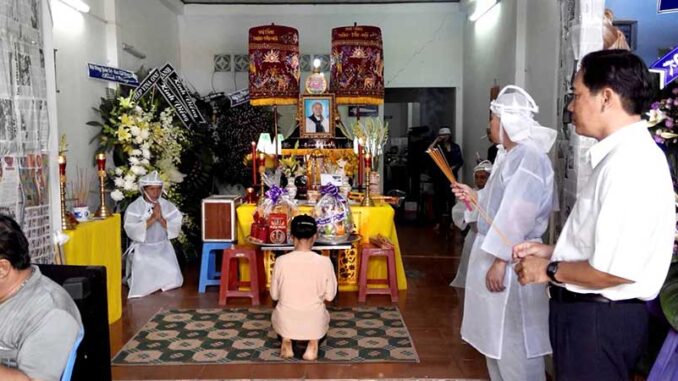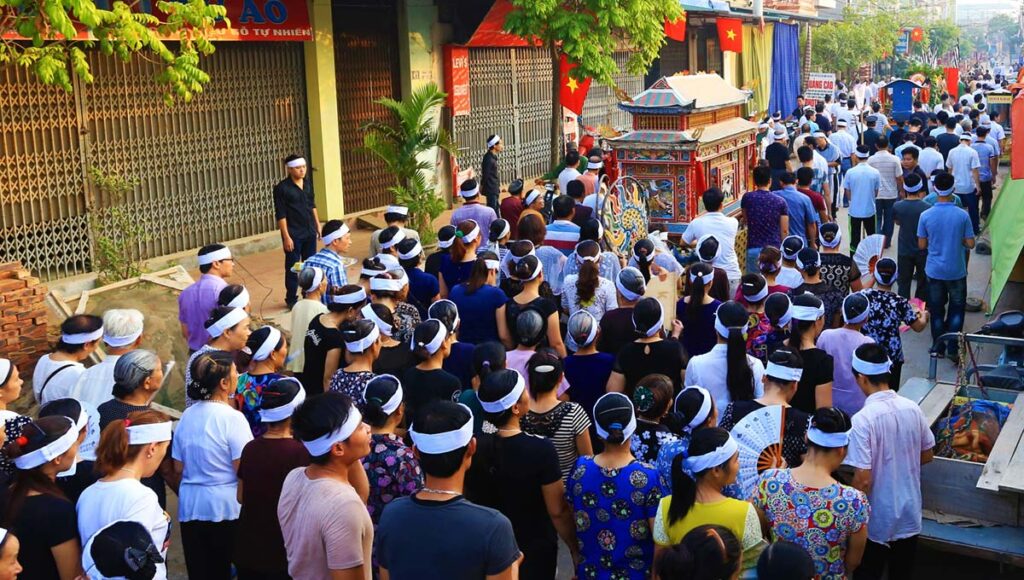
Vietnam is a country with a rich and diverse culture, which is reflected in many aspects of its people’s life. One of the most important and solemn occasions in Vietnamese culture is the funeral, which is a way of honoring the deceased and comforting the living. Vietnamese funeral traditions are influenced by various religions, beliefs, and customs, and they vary from region to region and family to family. However, there are some common elements and practices that are usually observed in most Vietnamese funerals. In this article, we will explore some of the main features and meanings of Vietnamese funeral traditions, and what to expect when attending a Vietnamese funeral.
The Preparation of the Body and the Wake
The preparation of the body and the wake are the first steps in the Vietnamese funeral process. The body of the deceased is usually washed, dressed, and placed in a coffin at home or at a funeral parlor. The coffin is then decorated with flowers, candles, incense, and paper money, which are meant to accompany the deceased in the afterlife. The coffin is also covered with a white cloth, which symbolizes purity and mourning.
The wake is a period of time when the family and friends of the deceased gather to pay their respects and offer their condolences. The wake can last from one to several days, depending on the preference and the budget of the family. During the wake, the family and friends take turns to keep vigil over the body, and to pray and chant for the soul of the deceased. The wake is also a time for sharing memories, stories, and emotions, and for expressing gratitude and love for the deceased.
The Funeral Service and the Procession
The funeral service and the procession are the next steps in the Vietnamese funeral process. The funeral service is usually held at a temple, a church, or a funeral home, depending on the religious affiliation and the belief of the family. The funeral service is led by a monk, a priest, or a funeral director, who performs the rituals and the ceremonies for the deceased. The funeral service may include prayers, readings, songs, and eulogies, as well as offerings of food, flowers, incense, and paper money for the deceased.
The procession is the part when the coffin is transported from the place of the funeral service to the place of the burial or the cremation. The procession is usually accompanied by music, such as drums, gongs, and horns, which are meant to scare away the evil spirits and to announce the departure of the deceased. The procession is also followed by the family and friends of the deceased, who wear white clothes and headbands, which indicate their grief and respect. The procession may also include vehicles, such as cars, buses, or motorcycles, which carry the mourners and the belongings of the deceased
The Burial or the Cremation and the Mourning Period

The burial or the cremation and the mourning period are the final steps in the Vietnamese funeral process. The burial or the cremation is the part when the body of the deceased is laid to rest in the ground or in the fire. The burial or the cremation is usually done at a cemetery or a crematorium, where the family and friends of the deceased say their final goodbye and farewell. The burial or the cremation may also involve some rituals and ceremonies, such as placing the coffin in a grave, covering it with soil, or placing the ashes in an urn, as well as burning more paper money and incense for the deceased.
The mourning period is three years for wives, children, daughters-in-law, and adopted children of the deceased man and only one year by husband’s, sons-in-law, brothers, sisters, nephews, nieces, and grandchildren of a woman. While in mourning, Vietnamese do not usually visit temples and pagodas, festivals, parties, and other entertainments. They also normally delay marriages and do not wear bright coloured clothing. A black band is worn on the arm by men in mourning and a small black piece of material is worn on the dress of women mourners after the funeral for the entire mourning period.
The Death Anniversary
The death anniversary and the ancestor worship are the parts that continue the Vietnamese funeral process beyond the death of the deceased. The death anniversary (Đám giỗ) is the day when the family and friends of the deceased commemorate and celebrate the life and the legacy of the deceased. The death anniversary is usually observed on the lunar calendar, and it is celebrated annually. During the death anniversary, the family and friends of the deceased may prepare a feast, invite guests, and make offerings of food, flowers, incense, and paper money for the deceased. They may also visit the grave or the urn of the deceased, and perform some rituals and ceremonies, such as cleaning, decorating, and repairing the grave or the urn, as well as praying and chanting for the soul of the deceased.
Vietnamese funeral traditions are a way of honoring the deceased and comforting the living, as well as expressing the culture and the identity of the Vietnamese people. Vietnamese funeral traditions are influenced by various religions, beliefs, and customs, and they vary from region to region and family to family. By understanding and respecting the Vietnamese funeral traditions, we can show our sympathy and support to the bereaved, and celebrate the life and the memory of the deceased.
Vietnam warmly welcomes you to explore Vietnamese culture deeply. Make your trip go smoothly as the very first step, and make your plan into reality by obtaining a Vietnam visa at https://www.vietnam-evisa.org.